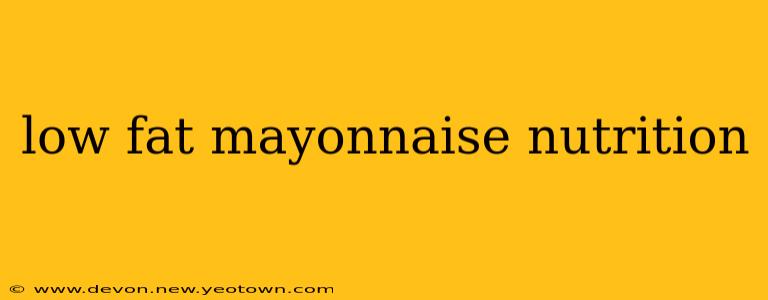Let's be honest, mayonnaise is a culinary chameleon. It transforms a simple sandwich into a gourmet delight, adds creamy richness to potato salad, and elevates a humble egg to a decadent masterpiece. But with its reputation for being high in fat, many health-conscious individuals shy away from this versatile condiment. Enter low-fat mayonnaise, a lighter alternative that still delivers that signature creamy texture we crave. But is it truly a healthier choice? Let's unravel the nutritional details and address some common questions.
What are the nutritional benefits of low-fat mayonnaise?
The primary benefit of choosing low-fat mayonnaise is, as the name suggests, a significantly reduced fat content. This translates to fewer calories per serving, making it a more suitable option for those watching their weight or aiming for a lower overall fat intake. However, it's crucial to remember that "low-fat" doesn't equate to "fat-free." The reduction in fat often leads to an increase in other ingredients, such as added sugars or thickeners, to maintain the desired consistency and taste. Therefore, carefully examining the nutritional label is paramount.
How does low-fat mayonnaise compare to regular mayonnaise?
The core difference lies in the fat content. Regular mayonnaise typically boasts a higher fat percentage, mainly from oils like soybean oil or canola oil. This contributes to its rich, creamy mouthfeel. Low-fat mayonnaise achieves a similar consistency by using less oil and potentially incorporating other ingredients like water or modified food starch. While regular mayonnaise provides a more substantial source of healthy fats (depending on the oil used), low-fat versions offer a lower calorie and fat alternative, making it a better fit for certain dietary goals.
What are the ingredients in low-fat mayonnaise?
The ingredient list of low-fat mayonnaise can vary depending on the brand. However, common ingredients include water, soybean oil (or other vegetable oils in smaller quantities), eggs, vinegar, and various stabilizers and thickeners. You'll also find added sugars in many brands, so reading the label carefully to check added sugars is a crucial step to ensure the mayo is suitable for your preferences. Some manufacturers opt for natural sweeteners, while others use high fructose corn syrup or other processed sweeteners.
Is low-fat mayonnaise healthier than regular mayonnaise?
This question doesn't have a simple yes or no answer. It truly depends on your individual dietary needs and goals. For someone actively trying to reduce their fat and calorie intake, low-fat mayonnaise can be a healthier alternative. However, if you're prioritizing healthy fats and aren't overly concerned about calorie counts, regular mayonnaise, particularly those made with high-quality oils like avocado oil, might be a better choice. Both offer different nutritional profiles and cater to varying dietary preferences.
Does low-fat mayonnaise have less cholesterol?
While the fat content is lower in low-fat mayonnaise, the cholesterol content might not be dramatically different. Cholesterol primarily comes from the egg yolks in mayonnaise. Since the egg content remains relatively consistent across both regular and low-fat varieties, you might not see a drastic reduction in cholesterol.
Can I use low-fat mayonnaise in baking?
Using low-fat mayonnaise in baking can result in a slightly different texture compared to recipes made with regular mayonnaise. The reduced fat content might lead to a less rich, less moist final product. While you can substitute it, it's recommended to start with a small test batch to see how it affects the final result.
In conclusion, low-fat mayonnaise provides a lighter alternative for those looking to reduce their fat and calorie intake. However, it’s crucial to read the nutrition label and choose brands with minimal added sugars. Ultimately, the "healthier" option depends on your individual dietary needs and preferences. Making an informed decision relies on understanding the subtle differences in nutritional profiles and choosing the option that best fits your lifestyle.

